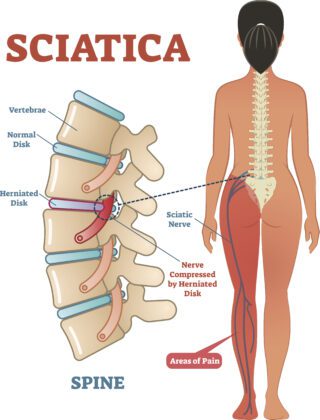Sciatica: Relief and Treatment

If you regularly feel a sharp shooting pain up the back of your leg or lower back, you may be experiencing sciatica. Sciatica isn’t an overly common condition, only affecting between 1 – 10% of Australians, however the pain can be significant, restrict movement and interfere with daily activities. Physiotherapy is an effective tool for sciatica treatment and pain relief. We also offer a comprehensive back pain treatment program which is led by our exercise physiologists. In this article, we’ll explore exactly what it means to have sciatica and some helpful exercises for sciatica pain.
What is sciatica?
Sciatica is the umbrella term for pain experienced in the sciatica nerve. You may recognise it as a shooting pain that runs up your leg into your lower back. It can also feel like a numb/ tingling sensation or weakness in the muscles between the leg and lower back. The sciatica nerve runs from the foot, up the back of the leg, through the buttock and hip, and roots in the lower back. It’s this root location in the back that causes the sensation of a sharp lower back pain that is commonly associated with sciatica. Men are three times more likely to experience sciatica, and the condition is most common in individuals over the age of 50. But that’s not to say people as young as 20 won’t experience sciatica.

What causes sciatica?
It’s important to note that a sciatica diagnosis does not necessarily provide insight into the source of the pain. At its crux, the pain is caused by an irritation, inflammation, pinching or compression of the nerve. This cause of this pain often falls into one of two categories – spinal causes or non-spinal causes. The most common cause of sciatic pain is lumbar bulging or herniated discs at the root of the nerve. This accounts for about 90% of sciatic pain cases. Certain spinal conditions, pregnancy, pelvic tumours and trauma to the leg can also traumatise the sciatica nerve.
Broadly speaking, sciatica tends to develop gradually, usually as a result of laborious work. Those who work in physically intensive roles that require regular heavy lifting, and bending at the hip, are more likely to develop sciatica later in life.
Sciatica treatment
Sciatica can be painful and restrictive, but it is also highly treatable through a range of techniques used in physiotherapy and in our back pain treatment program. It can also be common for sciatica to go away on its own with time. The goal of sciatica treatment is to remedy pain and increase mobility. The first line of treatment for sciatica should be either physiotherapy or assessment by our allied health team for participation in our back pain treatment program. A physiotherapist will be able to work closely to identify the source of your sciatica pain and from there, prescribe exercise for sciatica. Our experts can also provide physical treatments for immediate, short-term relief of sciatica pain.
Applying cold packs at the onset of pain is a simple sciatica pain treatment that can be implemented from home. After the first few days, switch to heat packs for short periods. Over the counter medication can also assist in remedying sciatica pain. These are steps you may wish to consider prior to seeing our practitioners.
Treatment for sciatica
The team at our physio Runaway Bay clinic can play a pivotal role in the treatment of sciatica pain. We also offer home visit physiotherapy. At Atkins Health, our qualified physios and allied health team work closely with sciatica sufferers to reduce inflammation and muscle tension at the source. This physical therapy approach to treatment for sciatica has been proven to deliver overall sciatica pain relief. The initial goal of physio treatment for sciatica is to relieve pain using massage, dry needling, nerve stretching and mobility exercises. Patients often report a reduction of pain within a few sessions. Once the pain has gone and our patient has regained their movement and mobility, our goal shifts towards long term prevention of sciatica pain. This is where professionally prescribed exercises for sciatica in our back pain treatment program make all the difference.
Ongoing treatment for sciatica employs exercises that focus on:
- Strengthening the muscles around the buttocks and lower back
- Core strengthening
- Targeted nerve mobility
- Spinal mobility
A one-on-one physiotherapy initial assessment or back pain program assessment provided the best opportunity for long term treatment of sciatica. Our team can implement a personalised treatment plan, targeted at underlying weaknesses or conditions which may be triggering your sciatica pain. Get in touch to book your first consultation today.


